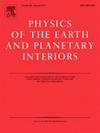Effects of geodynamo priors and geomagnetic data on inverted core surface flows
IF 1.9
3区 地球科学
Q2 GEOCHEMISTRY & GEOPHYSICS
引用次数: 0
Abstract
High quality continuous satellite magnetic data gives unprecedented insights into core surface motions but the inversion process remains under-determined, thus requiring additional information. We make use of the pygeodyn inversion tool, in which the core surface dynamics is forecasted with stochastic equations anchored to prior information from a geodynamo free run. There is no clear overview of the relative importance of the different ‘ingredients’ entering in the core flow inversion process, or of the robustness of the inferred flow features. We document the impact of three factors (or ‘ingredients’): (1) choice of geodynamo prior, (2) choice of geomagnetic field model, and (3) choice of maximum spherical harmonic degree for secular variation. We compare three field models (CHAOS-7, COV-OBS.x2 and Kalmag) and three truncation degree for secular variation. The six dynamo priors allow us to analyse the influence of changing the input parameters towards Earth-like values, changing the dynamo set-up (isotropic boundary conditions or not, stratified or not), and the torques at play.
We quantitatively show that changing the prior has a greater impact on the core surface flow than the choice of magnetic field model used as observations. This difference becomes less pronounced in the past due to the data quality decreasing and the field models showing more divergence. Furthermore, we find that the slowly evolving ‘background’ component of flow is more variable among models than the transient component. Transient flow motions appear very coherent for all considered dynamo priors and field models. The recovery from satellite measurements of subdecadal wave dynamics and of a growing eastward motion under the Pacific are robust and appear data driven. Finally, we quantify the efficiency of core flows for generating magnetic variations as a function of frequency. Normalized to their magnitude, rapid changes generate relatively more magnetic signal than slow variations. This is interpreted as the signature of a slow core dynamics approaching a state where induction is mitigated because of dynamical adjustment. As a consequence, a larger part of core surface motions enters the null-space of the kinematic core flow inverse problem towards long time-scales.

地球动力学先验和地磁资料对倒转岩心表面流动的影响
高质量的连续卫星磁数据提供了对地核表面运动的前所未有的深入了解,但反演过程仍然不确定,因此需要额外的信息。我们利用pygeodyn反演工具,在该工具中,岩心表面动力学是用随机方程来预测的,这些方程锚定在地球发电机自由运行的先验信息上。对于进入核心流反演过程的不同“成分”的相对重要性,或者推断出的流特征的鲁棒性,都没有明确的概述。我们记录了三个因素(或“成分”)的影响:(1)选择地球动力先验,(2)选择地磁场模型,(3)选择长期变化的最大球谐度。我们比较了三种现场模型(CHAOS-7、COV-OBS)。x2和Kalmag)和三个截断度的长期变化。六个发电机先验使我们能够分析改变输入参数对类地值的影响,改变发电机设置(各向同性边界条件与否,分层与否),以及发挥作用的扭矩。我们定量地表明,改变先验比选择磁场模型作为观测对岩心表面流动的影响更大。在过去,由于数据质量下降和现场模型显示出更多的分歧,这种差异变得不那么明显。此外,我们发现流动的缓慢演变的“背景”分量比瞬态分量在模型之间的变化更大。对于所有考虑过的发电机先验和场模型,瞬态流动运动显得非常一致。从卫星测量中恢复的年代际波动动力学和太平洋下不断增长的东移是可靠的,似乎是由数据驱动的。最后,我们量化了磁芯流产生磁变化的效率作为频率的函数。按其幅度归一化,快速变化比缓慢变化产生相对更多的磁信号。这被解释为一个缓慢的岩心动力学的特征,在这个状态下,由于动态调整,感应被减轻了。因此,在长时间尺度上,大部分岩心表面运动进入了运动学岩心流动反问题的零空间。
本文章由计算机程序翻译,如有差异,请以英文原文为准。
求助全文
约1分钟内获得全文
求助全文
来源期刊

Physics of the Earth and Planetary Interiors
地学天文-地球化学与地球物理
CiteScore
5.00
自引率
4.30%
发文量
78
审稿时长
18.5 weeks
期刊介绍:
Launched in 1968 to fill the need for an international journal in the field of planetary physics, geodesy and geophysics, Physics of the Earth and Planetary Interiors has now grown to become important reading matter for all geophysicists. It is the only journal to be entirely devoted to the physical and chemical processes of planetary interiors.
Original research papers, review articles, short communications and book reviews are all published on a regular basis; and from time to time special issues of the journal are devoted to the publication of the proceedings of symposia and congresses which the editors feel will be of particular interest to the reader.
 求助内容:
求助内容: 应助结果提醒方式:
应助结果提醒方式:


